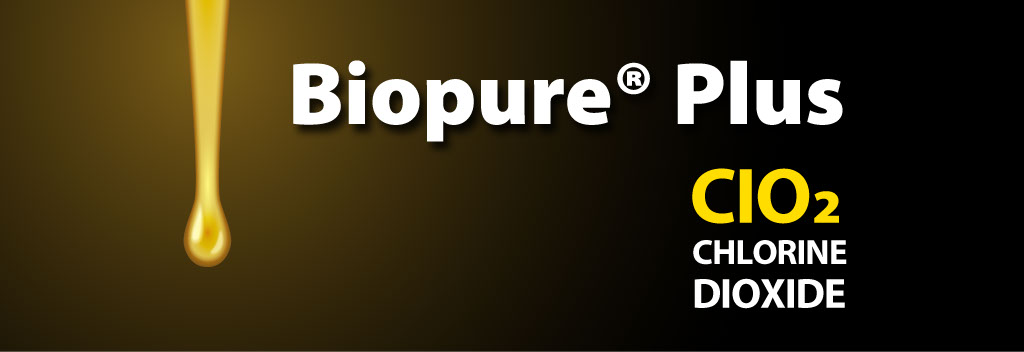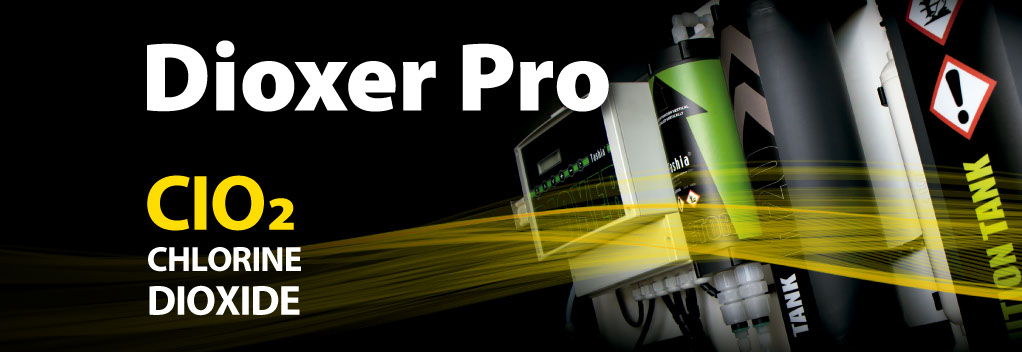

Biopure® safe and effective disinfection
Full range for all types of consumptions and applications
Biopure® is a range of equipment and products mainly designed for water treatments with in-situ-generated chloride dioxide as the active substance. The manual and automatic systems for the preparation of the product guarantee a chlorine dioxide purity of 99% or higher, with varying concentrations according to the products of the range.
Chlorine dioxide is also used in agriculture or aquaculture, among other sectors, as well as for the sterilization of medical and laboratory material and the disinfection of surfaces or tools.
The main features of Biopure® are:
it is a broad spectrum disinfectant (bacteria, fungi, viruses, etc.)
it destroys biofilms
it is highly effective, even in the presence of organic material
fast-acting, allowing for short contact times
it does not transfer odor or taste to water
no by-products from the disinfection are formed, such as THMs or chloramines
it can be used in a wide array of areas, regardless of the pH
high residual persistence
Key sectors

Hospitals
and clinics
Wastewater
and process
Food
industry
water cooling systems
Agriculture
cattle raising
Drinking
water
Why disinfect with Biopure®?
Decades of experience and research have revealed that much better disinfection can be achieved with chlorine dioxide, as it offers the necessary solutions for effective and safe disinfection.
The systems currently provided by Tashia s.l. for the generation of ClO2 from products from the Biopure® range are easy to handle, operate and control, and they guarantee proper disinfection in different applications, including:
drinking-water treatment
waste and process water
water refrigeration systems
agriculture
the food industry
The use of chlorine dioxide is increasingly replacing most of the disinfectants used up to now.
Preparation
of chlorine dioxide
Chlorine dioxide can be generated through various methods.
The Biopure® range is obtained through the acid method. The reaction is stated below.
This method can be obtained with the diluted or concentrated reagents.
Acid method
5 NaCIO2 + 4 HCI –> 4 CIO2 + 5 NaCI + 2 H2O
Disinfection characteristics
Chlorine dioxide is the most effective of the known chlorine derivatives and it has a greater oxidation capacity that others.
The table shows that chlorine dioxide (ClO2), for example, has an oxidation level 2.5 times higher than the oxidation level of chlorine.
Table 1. Availability of chlorine per mole.
AVAILABLE CHLORINE (%)
100
35-37
9,2
70-74
95,2
12-15
3-5
263,0
137,9
165,0
176,7
Chlorine (Cl2)
Bleaching powder
Calcium hypochlorite (Ca(OCl)2)
Commercial calcium hypochlorite
Sodium hypochlorite (NaOCl)
Industrial bleach
Domestic bleach
Chlorine dioxide (ClO2)
Monochloramine
Dichloramine
Trichloramine
AGENT
The disinfectant effect of chlorine dioxide is perceptibly better than chlorine in the same concentration.
Selective effect: no chloramines or trihalomethanes (THMs) are formed.
No odor or taste transfer to water.
Higher oxidation potential than chlorine. Highly effective, even in the presence of organic material.
Compared to other biocide products, chlorine dioxide is considerably more effective and faster in eliminating pathogens, including viruses, bacteria, spores, algae, fungi, etc. (Chart 1 and Table 2).
Chart 1.
Comparison of the disinfectant effect of chlorine dioxide and hypochlorous acid.
Ref.: HOFF, J. C.; GELDERICH, E. E. (1981). Comprarison of the Biocida Efficiency of Alternative Disinfectants.
Comparison of various disinfectants for water purification
Table 2. Table score values · 0 (worst) - 5 (best) · optimal results
BIOCIDE
EFFECTIVENESS
ODOR AND TASTE ISSUES
PERSISTANCE
EFFECTIVENESS ACCORDING
TO PH
HANDLING AND STORAGE RISKS
SPEED OF ACTION
REDOX
POTENTIAL
EFFECTIVENESS
IN PRESENCE
OF ORGANIC MATERIAL
Biopure®
Hydrogen peroxide
Sodium hypochlorite
Ozone
Chlorine gas
no
no
yes
no
yes
4
3
2
0
3
effective
conditional
conditional
effective
conditional
minimum
minimum
minimum
high
high
high
medium
slow
high
medium
effective
requires pretreatment
requires pretreatment
requires pretreatment
requires pretreatment
4
2
2
4
3
4
2
2
5
3